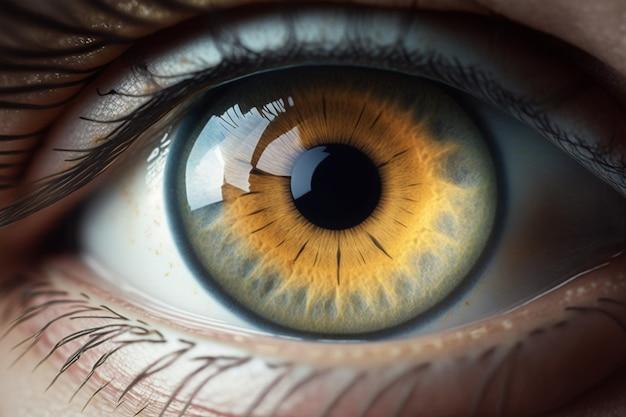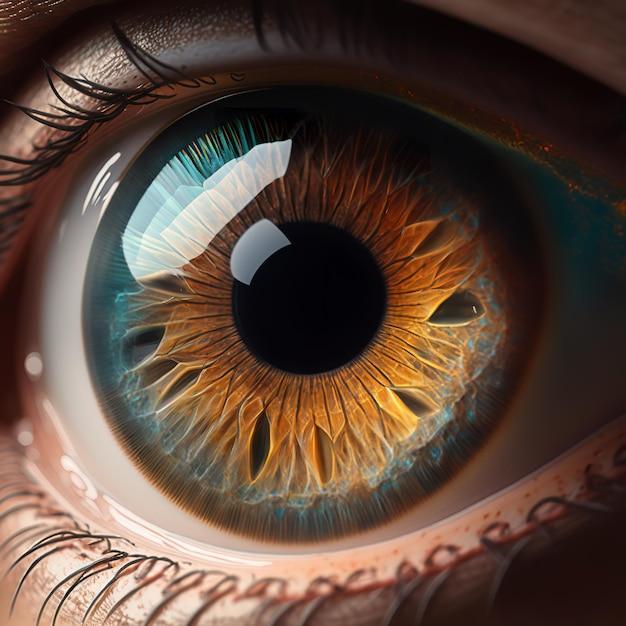Have you ever wondered how far our eyes can really see? Our eyes are incredible organs, capable of capturing a vast array of visual information from the world around us. But is there a limit to how much our eyes can take in? In this blog post, we will delve into the fascinating topic of the maximum angle a human eye can see.
From changes in the focal length of the eye lens to the muscles that make the pupil wider, we will explore the intricate workings of our eyes. We will also examine key terms such as the sharpness of vision and accommodation of the eye. Furthermore, we will shed light on how the shape of the lens changes and the distance between the lens and retina. So, join us as we unravel the mysteries of our extraordinary eyesight.
So, how far can our eyes really see? Let’s find out together!

What is the Maximum Angle a Human Eye Can See
Have you ever wondered how wide-ranging our vision is? As humans, we rely heavily on our eyes to take in the world around us. But what is the maximum angle our eyes can actually see? Let’s delve into this fascinating topic and uncover the secrets of our remarkable visual capabilities.
Exploring the Angular Horizon
When it comes to measuring the potential field of view for our eyes, we refer to it as the maximum visual angle. This angle represents the extent of our peripheral vision, which allows us to see objects outside the direct line of sight. It’s like having an invisible radar that gives us a broader understanding of our surroundings.
The Magic Number
So, what’s the magic number? The maximum angle a human eye can see is approximately 180 degrees horizontally! Yep, you heard that right – it’s almost as if we have a built-in panoramic camera. But before you start turning your head in all directions, bear in mind that this exceptional field of view is only achievable by combining the contributions of both eyes.
Appreciating Binocular Vision
Our eyes work together like a well-coordinated dance team to create what’s known as binocular vision. Each eye contributes a slightly different perspective, and our brain merges these two images into one cohesive view of the world. This collaboration enhances our depth perception, allowing us to accurately judge distances and locations of objects.
The Limits of Peripheral Vision
While our horizontal field of view is an impressive 180 degrees, our vertical visual angle is somewhat narrower, spanning around 135 degrees. This means our eyes have a greater focus on the horizontal plane, which makes sense given our upright posture and the need to navigate the world around us.
The Perks of Wide Vision
Having such a wide visual angle has numerous advantages. For example, it enables us to detect threats or potential prey from various directions, enhancing our survival instincts. Additionally, our impressive field of view aids in activities such as driving, sports, and even appreciating panoramic landscapes. It’s truly a 360-degree-eyesperience!
Beyond the Naked Eye
While our natural vision is remarkable, it’s worth mentioning that certain animals surpass our visual abilities. For instance, birds of prey, like the marvelous eagle, boast an even more expansive field of view. These magnificent creatures can see up to 340 degrees horizontally, thanks to their specialized eye structure. We humans can only look upon them with envy!
From the moment we open our eyes in the morning, the marvel of our visual system never ceases to amaze. Our eyes provide us with a wide-ranging perspective on the world, allowing us to navigate, explore, and appreciate the beauty that surrounds us. With a maximum angle of approximately 180 degrees horizontally, our eyes truly grant us a remarkable view of life’s grand cinema.

FAQ: Maximum Angle of Vision for the Human Eye
What Changes the Focal Length of the Eye Lens
The focal length of the eye lens can be adjusted through a process called accommodation. This amazing feature allows us to focus on objects at different distances. So, whether you’re admiring the intricate details of a tiny insect or gazing at the beauty of a distant landscape, your eye lens is dynamically altering its shape to provide you with a crystal-clear view.
What is the maximum angle a human eye can see
Ah, the million-dollar question! The human eye has an impressive field of view, spanning approximately 120 degrees horizontally and around 50 to 60 degrees vertically. This means we can soak in quite a substantial chunk of our surroundings without having to constantly turn our heads like an owl. So, next time someone asks you how wide your vision is, you can tell them it’s a panoramic extravaganza!
What is the Term for Sharpness of Vision
The term you’re looking for is visual acuity. It’s like the superpower that determines how well we perceive fine details. You know those Snellen eye charts hanging on the walls of optometrists’ offices? They test your visual acuity. The results are often followed by a series of complicated information, like 20/20 vision, which means you can see what the average person sees at a distance of 20 feet. So, if your visual acuity is tip-top, you might just have eagle-like eyes!
Which Muscles Make the Pupil of the Eyes Wider
It’s a dynamic duo of muscles that controls the size of our pupils: the iris sphincter and the iris dilator muscles. When the lighting conditions change, these muscles work their magic. The iris sphincter muscle contracts to make the pupil smaller, protecting our eyes from excessive light. On the flip side, the iris dilator muscle expands the pupil to let in more light when it’s dim. Isn’t it fascinating how our eyes instinctively know how to adjust?
What is the Length of the Eye
Well, let’s get technical for a moment. The length of an average adult eye is approximately 24 millimeters, or about 0.94 inches. Don’t worry; you don’t need to carry a ruler around to appreciate the wonders of your eyes. Just sit back, relax, and let your eyes do the marveling for you.
What is Eye Accommodation
Eye accommodation is like the fancy toggling mode for your eye lens. It’s the process through which the lens changes shape to bring objects at different distances into focus. As you shift your gaze from a close-up object to the distant horizon, your lens flexes, adapting its curvature to ensure a crisp image. It’s like having a built-in zoom feature, but without the buttons.
How Do You Test for Eye Accommodation
Oh, this one’s fun! There’s a clever little test called the “near point of accommodation.” Basically, it measures how close an object can be before your eyes start struggling to focus on it. So grab a book, bring it closer and closer to your face while reading, and watch as your eye lens works its magic. Just don’t blame us if you end up with your nose buried in the pages!
When Your Eye is Relaxed, Does the Lens
Nope, the lens doesn’t kick back and relax when your eye does. Even in a state of rest, the lens retains a slight curvature, ready to rapidly adjust when needed. It’s like having an Olympic sprinter constantly on standby, just waiting for the signal to race forward and focus on the next target.
What Changes the Shape of the Lens in the Eye
The boss here is the ciliary muscle. This muscular hero contracts and relaxes, pulling and releasing the suspensory ligaments that hold the lens in place. When the ciliary muscle teams up with the suspensory ligaments, it causes the lens to either become fatter or thinner, fine-tuning its shape for perfect vision. It’s like a shape-shifting wizardry happening inside your eye!
What is the White Part of the Eye
Ah, the “white” part of the eye has a fancy name: the sclera. It’s like the protective armor covering the majority of our eyeballs. Just imagine a sci-fi futuristic battle suit for your eyes; that’s the sclera. It not only provides structural support but also acts as a backdrop, making the colorful iris and the captivating twinkle of the cornea stand out even more.
What is the Distance Between the Lens and Retina of an Eye
About 17 millimeters, or roughly 0.67 inches. The lens, with all its marvelous accommodation powers, sits right in front of the retina, the light-sensitive part of the eye. Together, they form a dream team, ensuring the incoming light rays get focused onto the retina, where the magic of vision takes place.
So there you have it, a delightful and informative FAQ-style guide to the maximum angle of vision, the marvels of eye lens accommodation, the mystical muscles behind pupil control, and more. Now, armed with this knowledge, go forth and astound your friends at your next trivia night with your eye-related wisdom!
